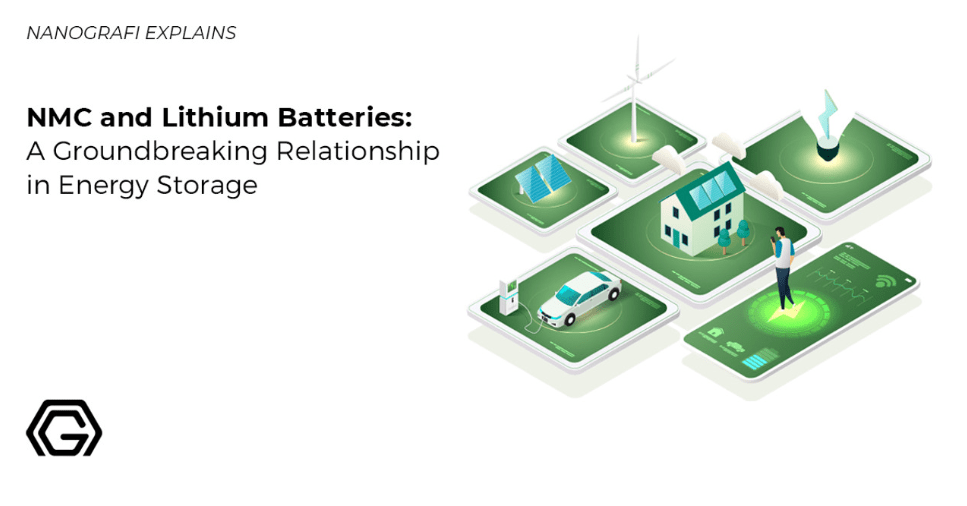Applications of Nanomaterials in the Construction Industry
Nanomaterials are particles that are making huge progress in the industry due to the remarkability of their properties and characteristics. Despite being too small in size they are known and renowned for the things that are highly appreciable in almost every field now.
Along with all the other fields nanomaterials are also being used excessively in the construction industry. They not only help in the construction processes but are also a way of eradicating the toxicity that is spread after that. Nanografi contributes to the development of advanced materials by using nanotechnology to improve the properties of construction materials.
Introduction
Nanomaterials are described as materials that are extremely tiny in size and their size varies from 1 to 100 nm which is usually measured in the form of nanoscale. Nanomaterials due to their amazing work and technicalities have made their mark in the market and are now emerging as commodities because of their commercialization and authenticity. Their external and internal dimensions are present in the nanoscale and as explained above their length always ranges from 1 to 100nm. They are one of the most amazing materials because they provide great characteristics to any and everything they are a part of. Their work dimensions have drastically increased over time and now they are a huge part of almost all the industries and the market. Their size and shape do not define their characteristics and that's why they are now being commercialized at such a huge scale. Nanomaterials have a lot of uses in a lot of fields and it is all due to their remarkability and their authentic performances in all the fields as they not only prove their work but also provide measures that ensure the authenticity of the said products and materials.
Properties of Nanomaterials in the Construction Industry
Nanomaterials' properties are insanely unique, both the physical and chemical ones. There is a lot of difference between the materials present at large scale and small scale because particles of such scale find it hard to identify their properties both the physical and chemical ones. The prominent ones are the shape, size, surface characteristics, and interior structure as well. They can also be known as the aerosols which means either the solids or the liquids present in the air, suspensions which means the presence of solids in the liquids, and emulsions as well which is a combination of liquids in liquids. If a certain amount of other materials are added to these, their properties can be altered and may be hindered by some variances.
A single nanoparticle has to be composed with a lot of complexity and that is why it is a huge task to compile a single nanoparticle. It is due to the type of other chemicals or particles that they either interact with or they combine with. All the chemical processes that they are a part of are very much unknown because they are very complicated and require a lot of attention and keen observations. The nanomaterials have hugely different types of ways when it comes to the interaction with either each other or the other compounds. It is totally up to them that they can either live free or can be grouped but that too solely depends upon the type of forces between them which can either be the attractive or the repulsive forces. Their characterization is very difficult owing to their interactions and the interactive forces present between them. A very distinctive feature that the nanomaterials exhibit is that the nanomaterials which are suspended in the gas remain stacked to each other as compared to the ones in the form of liquids.
Nanomaterials Applications in the Construction Industry
Nanomaterials have now paved their way in the construction industry and that is why this very revolution has brought an insane amount of changes in the products, services, and industries including the construction industry as well. It is very important to record an effect or impact that they cause on the environment and as well as on humans. There are a lot of benefits that nanomaterials have on the construction sector and the way that they protect the ecosystem is truly phenomenal. The nanomaterials are insanely small in size and due to their size, their performance is enhanced as the particles having a small size can exhibit advancements in the fields of catalysis, conductivity, magnetism, mechanical strength, and optical sensitivity as well. All these characteristics add up to a wide range of applications and are proving as a great material for the construction industry and all the processes that are involved in it.
Concrete
Nanomaterials have a wide range of applications in the field of construction and one of those is concrete. Concrete has the highest annual production as compared to all the other materials and this is due to the mixture of carbon nanotubes (CNTs) and the nanosized SiO2 as well as these enhance the concrete mixture which includes the binding phase as well as the aggregates. Concrete has a huge amount of nanomaterials and that is what makes them more applicable in the construction field. Their weightage though is not too much but all the nanomaterials combined to make a huge difference in the whole criteria and the scenario itself.
Steel
Steel is used for building purposes and bridge constructions. These face challenges following strength, resistance, and formability as well. This is due to their introduction in the field of metal nanoparticles (NPS). Along with that, the copper particles are used to lessen the surface roughness to improve the anti-corrosion activities too.
Window glass
Along with concrete and steel, window glass is also one such thing that can be used to accomplish a lot of functions by the addition of TiO2 and SiO2 both in the form of nanoparticles. When the nanoparticles of TiO2 are coated on the windows via a photochemical process then the reaction with sunlight and indoor light is productively used for the removal of both the dirt and the bacterial films as well if any of those are present. Whereas the silica layers or sheets which are present in the form of nanoparticles are used to fireproof the windows and are highly authentic. It is due to these properties and reasons that the usage of nanomaterials is being promoted at a huge level.
Minimizing the effects on the environment
As far as the advantages are concerned, there are some harmful effects too that might be caused due to the products and materials involved in the said field. However nanomaterials in the form of nano-electromechanical and micro-electromechanical systems (NEMS and MEMS). These are comprised of sensors that are either nano or micro in size as they have been a recent material of a lot of attention. They are highly being used for the protection of both the environment and the humans from any and every harmful effect that might be caused due to over-usage of the nanomaterials but the point is that nanomaterials themselves are used as a protective measure for eradicating the harmful effects on the environment.
Do you know how NMC improves the performance of lithium batteries? Learn now.
Evaluation of hazards
Before jumping to the conclusion as to how we can minimize the harmful effects on the environment, we need to evaluate the hazards that are a source of causing harm to the environment. To evaluate those very hazards a certain targeted biota is set which helps the researchers and the case studies as to what led the chemicals to improvise the hazards for the environment itself. Evaluation is important as it gives a lead towards the main and root cause of the problem and a problem can only be solved if its root cause is known completely. Nanomaterials play a huge role in such identification and evaluation and that is why they are now being used more progressively in comparison to their past usage.
Waste management
The waste that is collected throughout the entire construction process has to be and needs to be managed properly because if that waste will be left open in the environment then it will cause a lot of potentially high health risks. Nanomaterials are very useful for such purposes and are effectively used for the management of wastes. These materials are a great source of protecting the environment and the humans from all the toxicity that the waste can bring along if it is left untreated and compiled in a single place in the form of garbage.
Construction wastes
There are a certain set of wastes that are generated while repairing, renovating, and any construction activities. To get rid of those very construction wastes it is important to dispose of them in the right places at the right time to avoid any hazardous harm in the form of health risks.
Manufacturing
A lot of products are released into the environment when the process of manufacturing is being carried out. It is important to get rid of all those hazardous materials that in one way or another are causing serious effects to the environment and humans both. To continue with this process, nanomaterials are used in bulk to make resources that will work as the protective agent for the environment and humans. Their harm can be so adverse that they can cause death-causing diseases too if left untreated. However, nanomaterials when adequately used can serve this purpose and act accordingly for the betterment of the environment.
Conclusion
The construction industry itself is huge and for its successful movement, a lot of materials and factors play a role and nanomaterials are one such thing. They are highly capable in their work and that is why their demand in every industry is now increasing rapidly. Their remarkable features in the construction industry make them an integral part of the industry itself.
To get more information, you can visit Blografi.
References
Künniger, T., Hischier, R., Hincapié, I., Caballero-Guzman, A., Hiltbrunner, D., & Nowack, B. (2015). Use of engineered nanomaterials in the construction industry with specific emphasis on paints and their flows in construction and demolition waste in Switzerland. Hincapié Nano in CDW, 1. https://doi.org/10.1016/j.wasman.2015.07.004
Nanomaterials - Wikipedia. (n.d.). Retrieved February 29, 2024, from https://en.wikipedia.org/wiki/Nanomaterials
NMC and Lithium Batteries: A Groundbreaking Relationship in Energy Storage - Nanografi - Nanografi Nano Technology. (n.d.). Retrieved February 29, 2024, from https://nanografi.com/blog/nmc-and-lithium-batteries-a-groundbreaking-relationship-in-energy-storage-nanografi/
SiO2 Nano powder: Properties & Applications - Nanografi Nano Technology. (n.d.). Retrieved February 29, 2024, from https://nanografi.com/blog/sio2-nano-powder-properties-applications/
Titanium Oxide Nanopowder/Nanoparticles Specifications - Nanografi Nano Technology. (n.d.). Retrieved February 29, 2024, from https://nanografi.com/blog/titanium-oxide-nanopowdernanoparticles-specifications/
Recent Posts
-
Nanocomposites in Food Packaging
The utilization of nanocomposites in food packaging represents a significant advancement in the fiel …19th Apr 2024 -
What is the Difference Between 7075 and 6061 Aluminum Alloy?
When comparing 7075 aluminum alloy to 6061 aluminum alloy, it's essential to understand their disti …5th Apr 2024 -
Iron-Air Batteries: The Ultimate Guide
Iron-air batteries represent a significant breakthrough in energy storage technology, offering a sus …29th Mar 2024







